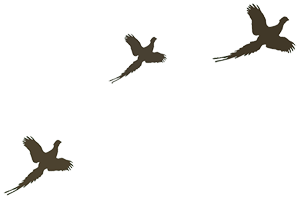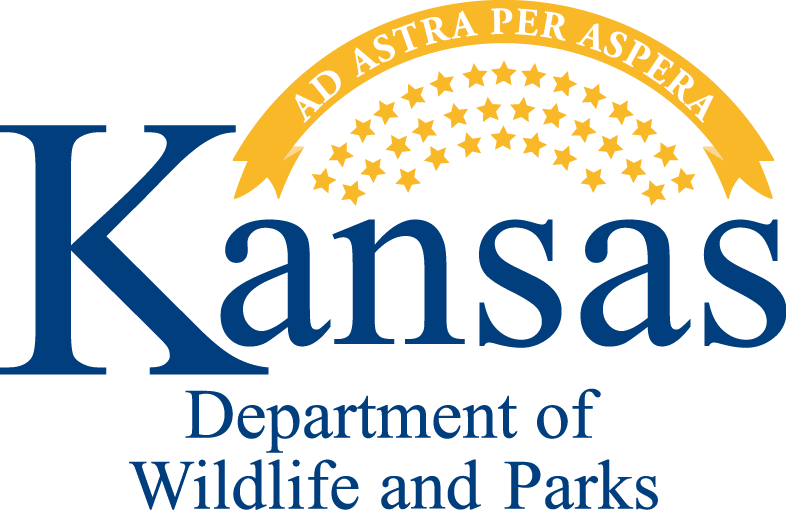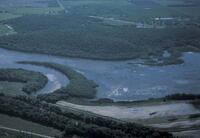Marais des Cygnes Wildlife Area
Marais des Cygnes Wildlife Area (7,654 ac) lies in the floodplain of the Marais des Cygnes River and is unique for its quantity of managed wetlands and bottomland hardwood forest. The array of wetland units are managed for a diversity of habitat types, producing abundant food and cover for migratory waterfowl and other wetland species. In general, wetlands are dewatered in the spring and reflooded in the fall with water pumped from the river.
Bottomland hardwood forests are dominated by oak and hickory and are excellent habitat for wild turkey, white-tailed deer, squirrels, and, during wet seasons, waterfowl that use forested wetlands. In addition to wetlands and bottomland forest, the area features upland forest, upland and wet-meadow prairie, restored native grasslands, and cropland.
Waterfowl and wetland management, and hunting recreation are primary objectives for this area. Marais des Cygnes is best known for waterfowl hunting, but also provides quality white-tailed deer, wild turkey, and squirrel hunting. Archery deer hunting is very good and can be very productive. All hunters, regardless of species pursued, are required to check-in before hunting and check-out after the hunt (regardless of success). Go to: https://ksoutdoors.com/checkin for registration and check-in.
Although the primary focus of the area is wetland and waterfowl management, angling for catfish in the Marais des Cygnes River and tributary streams can be excellent. In addition, fishing is allowed in marsh units from April 15 through September 15. Fish salvages are allowed by posted notice when marsh units are dewatered for wetland management.
Birding and wildlife watching are popular activities. Birding is particularly spectacular during spring migrations (April through mid-June). Pecan picking and mushroom hunting are also seasonally popular.
Users of the Wildlife Area may also be interested in the adjacent Marais des Cygnes National Wildlife Refuge managed by the U.S. Fish and Wildlife Service. Click link to NWR Home Page for more information.
For a full-color map of both the state Wildlife Area and federal National Wildlife Refuge click Map link.
To receive the Marais des Cygnes News click the newsletter link.
Manager: Jacob Coulter:
Phone: (913) 352-8941
6 mi N of Pleasanton on US Hwy 69
Area News
River boat ramp: The new river boat ramp has been completed and is located south of 1700 rd, on the west side of the river, adjacent to the main pumping station.
All hunters, regardless of species, are required to check-in before hunting and check-out after the hunt (regardless of success). Go to: https://ksoutdoors.com/checkin
Trees stands may not be placed more than 14 days prior to the season and must be removed within 14 days of the end of season. Portable blinds may not be left unattended overnight. Only two blinds or stands are allowed per hunter. Blinds and stand must be clearly marked with owners name and address or KDWPT number.
No person shall place, deposit, expose, or scatter bait for hunting.
Closed areas (refuge) are closed to all activities year-round.
Non-toxic shot is required for all hunting.
Target shooting is prohibited.
Here is a complete list of Public Land Regulations or you can download the regulation summary.
Most of the wildlife area was purchased in 1953-55, with additions through 2008. The area currently encompasses over 7,650 acres.
- Type of Facility: Boat Ramp
- Location of Facility: N38 13.576 W94 41.657
- Click for more information
- Type of Facility: Information Center
- Location of Facility: N38 15.790 W94 40.788
- Click for more information
- Type of Facility: Primitive camping
- Location of Facility: N38 17.116 W94 44.032
- Click for more information
- Type of Facility: Primitive camping
- Location of Facility: N38 15.256 W94 42.161
- Type of Facility: Primitive camping
- Location of Facility: N38 14.844 W94 41.608
- Type of Facility: Boat Ramp
- Location of Facility: N38 17.051 W94 44.981
- Click for more information
- Type of Facility: Boat Ramp
- Location of Facility: N38 16.818 W94 44.027
- Click for more information
- Type of Facility: Boat Ramp
- Location of Facility: N38 13.640 W94 41.970
- Click for more information
- Type of Facility: Boat Ramp
- Location of Facility: N38 15.149 W94 42.173
- Click for more information
| Waterfowl numbers | ATTENTION HUNTERS: There is a new check-in system All hunters must check-in daily To check-in / check-out. Hunters, go to this site: https://ksoutdoors.com/checkin Use your licensing login credentials to access the check-in / check-out functions. LEGAL SHOOTING TIME FOR WATERFOWL ENDS AT SUNSET! Waterfowl species observed: none observed
|
| Water levels | 99% Frozen
Water Level Gauges: A-North (Reese Lake/north structure): 23" A-North (middle structure): 35" A-North (south structure): 29" A-East at ramp: 17" A-East at outlet: 36" C-South at outlet: 26" Unit D wetlands: some units with adequate water Unit E wetlands: mid to upper elevations F-East at outlet: 40" F-South at outlet: 21" F-West at outlet: 18" Unit G: 19.5" Unit H: little to no water Refuge Units: B-North: 24" B-South: 34" C-North: lowest elevations. Staff use these gauges to help manage water levels through both pumping and drawdowns. We will try to provide the level of water as it reads on the gauge. Hunters should keep in mind this value should be used as an index. If the gauge reads 15", it doesn't mean there's 15" of water across the whole unit the gauge reading should be used as a reference. Over time it should help provide a better answer to one of the most common questions we get. "How much water is in _____ unit?" |
| Hunting/ Habitat conditions | Moist soil food production was below average to average this growing season. It was a little too wet early and then the summer heat and dry conditions had the cocklebur growing really well. We have dedicated lots of time to controlling it, but hunters should expect it throughout the area. Army worms have devastated large areas on the Wildlife Area. A mix of millets were planted in A-East, F-West, F-South and C-North. Over 90% was wiped out by army worms in A-East. Approximately 60 acres of standing corn have been left in C-South. Summer vegetation was good: F-East and A-North. There will be some large areas of cocklebur in the lower elevations of F-East. Summer vegetation was fair: in F-South, and F-West Summer vegetation was poor to fair: Unit G. Cocklebur and army worms have impacted 90% of the unit. Summer vegetation was very poor in A-East. The entire unit was aerial seeded with Jap Millet and almost completely consumed by army worms. If you like the habitat or water levels in wetlands, be sure to thank the following staff: Seasonal technicians: Cody and Ron or Habitat Specialist: Sam If there's something you don't like on the area, be sure to tell the Area Manager, Jacob. Hope everyone has a great season. Enjoy your time in the field!
|
| Season Dates | LOW PLAINS TEAL: Sept. 14-29, 2024 SOUTHEAST ZONE YOUTH/MILITARY: Nov. 2-3, 2024 SOUTHESAT LATE ZONE DUCK SEASON OPENS Nov. 9, 2024 - Jan. 5, 2024 and Jan 11-26, 2025 WHITE-FRONTED GOOSE OPENS Oct. 26, - Dec. 29, 2024 and Jan. 25 - Feb. 16, 2025 CANADA GOOSE SEASON OPENS Oct. 27-28, 2024 and Nov. 6 - Feb. 16, 2025 Light GOOSE SEASON OPENS Oct. 26-27, 2024 and Nov. 6 - Feb. 16, 2025 Conservation Light Goose season is from February 17 - April 30, 2025 |
| Comments | Please report all banded waterfowl to the appropriate agencies. Gas motors are restricted to Unit G and the boat lane in Unit A-East. Outboards cannot be used in any other wetland units. Electric trolling motors are unrestricted. Atv's of any kind are not allowed on the area (side by sides, utv's, amphibious vehicles, "argos", this also means no electric bicycles) Campgrounds on the area are primitive. (No electric, No water) Take your trash with you! Please remember to fill out the daily permit with accurate information. THIS INFORMATION IS VERY IMPORTANT TO THE CURRENT AND FUTURE MANAGEMENT OF THE AREA. FILL OUT ONLY YOUR INDIVIDUAL HARVEST EFFORTS, each individual hunter needs to check in/out and report his/her harvest totals. i.e., NOT A GROUP HARVEST TOTAL. |












